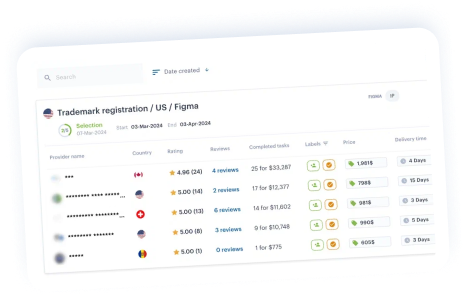By: Manchee Liu, Way Insight IP Services LTD
As a global leader, the UK has a strong presence in various industries, sciences, and technological fields. As of 2021, the UK’s GDP has reached $3.188 trillion, reflecting its position as a major player in the global economy. Given the UK’s significant market share, investors continue to show a strong interest in registering trademarks in the country.
In this article, we will guide you through the process of registering a trademark in the UK, including the prerequisites, required documents and the application process.
Contents
1. What can be registered as a trademark in the UK?
2. Why can you be refused to register a trademark in the UK?
3. The process of trademark registration in the UK
4. Documents required for registering a trademark in the UK
5. Trademark opposition process in the UK
6. Costs of trademark registration in the UK
1. What can be registered as a trademark in the UK?
By registering your trademark, you can protect your brand, including the name of your product or service, from being used by others without your permission. Some of the benefits of registering your trademark include:
- taking legal action against anyone who uses your brand without your permission, including counterfeiters;
- using the ® symbol to show that your trademark is registered and protected;
- selling and licensing your trademark to others;
- using your trade mark to create a strong and recognizable brand image for your products or services.
A trademark lasts for a period of 10 years, after which it must be renewed to remain in force.
Your trade mark can include:
- words;
- sounds;
- logos;
- colors;
- combinations of any of these elements.
In the United Kingdom, it is imperative to precisely classify the goods and services associated with your trademark for successful registration. This classification should comply with the International Classification of Goods and Services, ensuring uniformity in trademark registrations worldwide.
Additionally, you have the option to submit a multi-class trademark application. This allows you to register multiple classes of goods and services under a single trademark. However, for each additional class, you will incur an extra fee.
2. Why can you be refused to register a trademark in the UK?
Your trademark application may be refused if it falls under any of the following categories:
- Offensive: if it contains profanity or pornographic content;
- Descriptive: if it directly describes the goods or services it will relate to (e.g. “cotton” cannot be a trademark for a cotton textile company);
- Misleading: if it uses terms like “organic” for goods that are not organic;
- Non-distinctive: if it is too common or lacks originality (e.g. “we lead the way”);
- Generic: if it’s just a generic shape associated with your business (e.g. the shape of an apple for a company that sells apples);
- Use of national flags or official emblems: if you do not have permission to use them;
- Confusion with an existing trademark: if it’s the same as, or similar to, a trademark of another business that sells the same goods or services.
To increase your chances of successful registration, it is essential to conduct a thorough trademark search and carefully consider the distinctiveness of your trademark before applying.
3. The process of trademark registration in the UK
The trademark registration process in the UK is a comprehensive procedure that entails several stages, including a trademark search, submitting the application, undergoing examination, addressing potential oppositions, and ultimately, obtaining the registration certificate.
Before applying for a trademark, make sure to search thoroughly for existing trademarks or pending applications to avoid conflicts with your desired trademark. You can do this using the UK Intellectual Property Office‘s (UKIPO) online search tool. You may also consider hiring a professional to assist with the search process or use a global IP search tool.
When you’ve ensured that your trademark is available and fulfills registration requirements, you can proceed with your application to the UKIPO. Your application must contain vital information, including a representation of the mark, the goods or services it represents (sorted by the Nice Classification system), and applicant details. You have the option to apply online or via post, accompanied by the necessary fees.
Upon receiving your application, the UKIPO will scrutinize it to verify that it complies with registration standards. If any issues arise, the IPO will notify you, and you must address them before registering your trademark. If there are no problems, your trademark will typically be granted within 3 to 4 months from the application date.
Once your application clears the examination phase, it will be published in the UKIPO’s Trademarks Journal. This publication initiates a two-month period during which any third party may challenge your trademark’s registration. Oppositions can arise from various factors, such as existing trademark rights, bad faith, or insufficient distinctiveness.
If there are no oppositions, or if you successfully address any that are raised, your trademark will be registered. The UKIPO will issue a registration certificate, effectively protecting your trademark within the UK.
The trademark registration remains valid for ten years from the filing date and can be renewed indefinitely in ten-year intervals. To maintain the registration, you must pay renewal fees and continue using the trademark for the designated goods and services. Read our guide about trademark registration process.
4. Documents required for registering a trademark in the UK
To register a trademark in the UK, you need to submit the following documents:
- A completed trademark application form.
- A clear representation of the trademark.
- A list of the goods and/or services for which the trademark will be used
- A priority document, if claiming priority
- Payment of the required fees.
All documents and information submitted for trademark registration in the UK should be in English. If any supporting documents are in another language, you may be required to provide a certified translation into English.
5. Trademark opposition process in the UK
After the trademark enters the publicity period, other parties may raise objections to the trademark application. The main reasons for raising objections are:
- Conflicts with other registered trademarks;
- Lack of distinctiveness in the trademark;
- Adverse effects of the trademark;
- Malicious registration;
- Infringement of other rights, such as trade name rights, design, copyright, person name, etc.
Interested parties have a two-month period from the publication date to file an opposition, which can be extended by an additional month. The process involves filing a Notice of Opposition, the applicant responding with a Counterstatement, and both parties submitting evidence to support their claims. A UKIPO hearing officer will review the case, make a decision, and inform both parties, with the option to appeal if either party disagrees.
During the period of trademark publication, if there are no objections or if the objections are not tenable, the trademark may be approved for registration and a registration certificate may be issued.
6. Costs of trademark registration in the UK
Government fees of trademark registration in the UK are the following:
| Procedure | Official fees (GBP) |
| Application to register a trade mark | 170 |
| Each additional class | 50 |
| Application to start invalidation proceedings | 200 |
| Application to revoke a trade mark for reasons of non-use | 200 |
| Application to revoke a trade mark for reasons other than non-use | 200 |
| Application to amend the regulations governing the use of marks | 100 |
| Renewal of trade mark registration | 200 |
| Renewal additional class | 50 |
| Renewal late payment | 50 |
| Request to restore and renew a registration | 100 |
| Application to record a change of ownership | 50 |
| Application to record partial assignment of goods and/or services | 50 |
The trademark registration cost in the UK via the iPNOTE platform starts from as low as $400, which includes all government fees and document preparation. Find the best trademark attorney in the UK on iPNOTE.
7. Final thoughts
The main advantages of registering a trademark in the UK are the short registration cycle and relatively low cost, making it a popular option for many businesses. As a developed country, the UK offers access to a large consumer market that should not be overlooked, and registering a UK trademark can contribute to the growth and success of a business.
***
The iPNOTE platform features more than 700 IP law firms that cover more than 150 countries, so you can always find the right direct service provider using our flexible filtering system.
Do you need help with trademark registration in the UK? Contact Way Insight IP Services LTD now via IPNOTE to learn more and get started.
Sign up for free, and we’ll help you solve any IP-related problem.
Ensure continuous brand protection with trademark renewal in Indonesia, coupled with efficient trademark registration in Japan.







